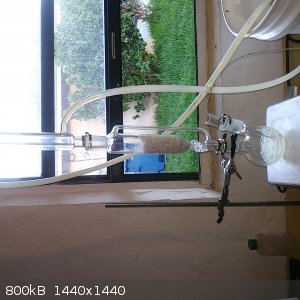
VSEPR_VOID - 15-8-2018 at 15:13
Vogel Practical Organic Chemistry describes the preparation of diacetone alcohol. A soxhlet apparatus i charged with acetone and barium hydroxide, so
that the condensed acetone passed over the strong base regularly as the apparatus functions.
I have recently been trying to do something similar using hardware store acetone and a pressure equalizing funnel. (See the attached photo)
Does anyone know why this sort of apparatus must be used? Why not just reflux the acetone directly with the catalyst?

Ozone - 15-8-2018 at 17:17
I'd suppose the idea is to remove the product from the catalyst as soon as it is made so as to prevent further condensation.
O3
VSEPR_VOID - 15-8-2018 at 17:52
I dont imagine that being the case. Diaceont is a much larger molecule than acetone, so it would serve to reason that it would require more energy to
undergo self-aldolation. So the reaction should favor the further synthesis of diacetone from acetone, rather than higher alcohols from diacetone. In
addition there is much more acetone than diacetone in the flask.
bobm4360 - 15-8-2018 at 21:09
Discussion and references here:http://www.orgsyn.org/demo.aspx?prep=CV1P0199
VSEPR_VOID - 15-8-2018 at 23:01
Okay, so the reaction can occur in either direction when heated with the catalyst, but when only acetone passes over the catalyst the product is
favored.
I still wish there was a way to do this that does not involve days of reflux. I want to use my glassware and hotplate for other projects.
fusso - 16-8-2018 at 00:47
DAA can be dehydrated into mesityl oxide so I guess the condensation in lower temperature in soxhlet favours DAA instead of MO?
wildfyr - 16-8-2018 at 09:07
VSPER, you are right about the kinetics of forming the dimer, however at the end of the reaction that will not be the case. At a certain point there
is more dimer than monomer, and you will start getting trimer, tetramer, etc. Its not about reactivity, but rather statistics.
Its follows the rules of a condensation polymerization. In this reaction we assume (and its a good assumption) that every functional group is equally
reactive, regardless of molecule weight. Pure statistics of concentration govern what species form.
In polymers, reactivity of end groups is usually only lower at high MW.
VSEPR_VOID - 16-8-2018 at 17:16
Results, no yield.
After refluxing 50 mL of acetone, with regular passage over barium hydroxide via a pressure equalizing funnel, I did not collect any diacetone after
distillation.
I am going to assume this is because the acetone did not spend enough time passing over the barium hydroxide.
I did collect a fraction of yellow liquid at about 90C. No idea what it is. Now I have to start cleaning up the barium mess in the glassware.
